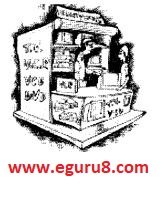Class 8 Maths Chapter 8 Comparing Quantities Exercise 8.2 Solution of NCERT
Introduction:
In this Exercise 8.2 we will learn about finding the increase or decrease percent.
Discount is a reduction given on the marked price( Discount = Marked Price - Sale Price).
Sales Tax (ST) is charged by the government on the sale of an item. Therefore, on selling price of an item and is added to the value of the bill.
VAT is another type of Tax which is Included in the price known as Value Added Tax.

Class 8 Maths Chapter 8 Comparing Quantities :
- NCERT Class 8 Maths Chapter 8 Comparing Quantities Exercise 8.1
- NCERT Class 8 Maths Chapter 8 Comparing Quantities Exercise 8.2
- NCERT Class 8 Maths Chapter 8 Comparing Quantities Exercise 8.3
Class 8 Maths Exercise 8.2 (Page-125)
Q1. A man got a 10% increase in his salary. If his new salary is ₹ 1,54,000, find his original salary.
Solution: Let the original salary be x
Increase of salary = 10% of x= (\(\displaystyle \frac{{10}}{{100}}\times x\))
So, new salary will be x + 10% of x
According to given data
154000= x + ![]()
154000=![]()
154000 =![]()
154000 × 100 = 100x + 10x
15400000 = 110x
![]()
x = 140000
So, his original salary is ₹1,40,000.
Q2. On Sunday 845 people went to the Zoo. On Monday only 169 people went. What is the per cent decrease in the people visiting the Zoo on Monday?
Solution: Number of people went on Sunday = 845
Number of people went on Monday = 169
Decrease in number = 845 - 169 = 676
So, percent decrease = ![]()
= ![]()
= 80
So, the per cent decrease in the people visiting the Zoo on Monday is 80%.
Q3. A shopkeeper buys 80 articles for ₹ 2,400 and sells them for a profit of 16%. Find the selling price of one article.
Solution: By using unitary method we will find cost price of 1 article
C.P of 1 article = \(\displaystyle \frac{{2400}}{{80}}\)
=30
Profit = \(\displaystyle \frac{{2400}}{{80}}\)
= \(\displaystyle \frac{{16\,\times \,30}}{{100}}\)
= \(\displaystyle \frac{{480}}{{100}}\)
= 4.8
S.P of one article = C.P of one article + Profit
= 30 + 4.8
= 34.8
So, the selling price of 1 article is Rs 34.8 .
Q4. The cost of an article was ₹ 15,500. ₹ 450 were spent on its repairs. If it is sold for a profit of 15%, find the selling price of the article.
Solution: Cost Price of an article = 15500
Money spent on repair = 450
So, the net Cost price i s= 15500 + 450
= 15950
Profit = \(\displaystyle \frac{{\Pr ofit\%\,\times \,C.P}}{{100}}\,\)
= \(\displaystyle \frac{{15950\,\times \,15\,}}{{100}}\)
= \(\displaystyle \frac{{239250}}{{100}}\)
= 2392.50
S.P = C.P + Profit
= 15950 + 2392.50
= 18342.50
Hence, the selling price of the article is Rs 18342.50 .
NCERT Class 8 Maths Chapter 8 Comparing Quantities Exercise 8.2
Q5. A VCR and TV were bought for ₹ 8,000 each. The shopkeeper made a loss of 4% on the VCR and a profit of 8% on the TV. Find the gain or loss per cent on the whole transaction.

Solution: C.P of VCR = Rs 8000
Loss on VCR = \(\displaystyle \frac{{Loss\%\,\times \,C.P}}{{100}}\)
= \(\displaystyle \frac{{4\,\times 8000\,}}{{100}}\)
= \(\displaystyle \frac{{32000\,}}{{100}}\)
= Rs 320
S.P of VCR = C.P - Loss
= 8000 - 320
= Rs 7680
C.P of T.V = 8000
Profit = \(\displaystyle \frac{{\Pr ofit\,\%\,\times \,C.P}}{{100}}\)
= \(\displaystyle \frac{{8\,\times \,8000\,}}{{100}}\)
= \(\displaystyle \frac{{64000\,}}{{100}}\)
= Rs 640
S.P of T.V = C.P + Profit
= 8000 + 640
= Rs 8640
So, the total C.P of VCR and T.V = 8000 + 8000
= 16000
Total S.P of VCR and T.V = 7680 + 8640
= Rs 16320
Hence, S.P > C.P.
So, the shopkeeper gained profit.
profit = S.P - C.P
= 16320 - 16000
= Rs 320
Profit % = \(\displaystyle \frac{{\Pr ofit\,}}{{C.P}}\,\,\times \,100\)
= \(\displaystyle \frac{{320\,}}{{16000}}\,\times \,100\)
= \(\displaystyle \frac{{32000\,}}{{16000}}\)
= \(\displaystyle \frac{{32\,}}{{16}}\)
= 2
Hence the shopkeeper 2% profit on whole transaction.
Q6. During a sale, a shop offered a discount of 10% on the marked prices of all the items. What would a customer have to pay for a pair of Jeans marked at ₹ 1450 and two shirts marked at ₹ 850 each?
Solution: Marked Price of jeans and two t- shirts are = 1450 + 850 +850
= Rs 3150.
Using Unitary method = \(\displaystyle \frac{{10\,}}{{100}}\,\times \,3150\)
= \(\displaystyle \frac{{31500\,}}{{100}}\)
= Rs. 315
So, the sale price = marked price - discount
= 3150 - 315
= 2835
Hence , the customer have to pay Rs 2,835 for a jeans and two shirts.
Q7. A milkman sold two of his buffaloes for ₹ 20,000 each. On one he made a gain of 5% and on the other a loss of 10%. Find his overall gain or loss. [Hint: Find CP of each]

Solution: Let the C.P be = \(\displaystyle x\)
C.P = SP - Profit
\(\displaystyle x\) = 20000 - \(\displaystyle \frac{5}{{100}}\) × \(\displaystyle x\)
\(\displaystyle x\) = 20000 - \(\displaystyle \frac{{5x}}{{100}}\)
\(\displaystyle x\) + \(\displaystyle \frac{{5x}}{{100}}\) = 20000
\(\displaystyle \frac{{100x\,+5x}}{{100}}\) = 20000
105\(\displaystyle x\) = 20000 × 100
105\(\displaystyle x\) = 2000000
\(\displaystyle x\) = \(\displaystyle \,\frac{{2000000}}{{105}}\)
\(\displaystyle x\) = \(\displaystyle \,\frac{{400000}}{{21}}\)
\(\displaystyle x\) = 19047.62
So, the C.P of 1st buffalo is Rs. 19047.62 .
C.P of 2nd buffalo = S.P + Loss
\(\displaystyle x\) = 20000 + \(\displaystyle \frac{{10}}{{100}}\) × \(\displaystyle x\)
\(\displaystyle x\) = 20000 + \(\displaystyle \frac{{10x}}{{100}}\)
\(\displaystyle x\) - \(\displaystyle \frac{{10x}}{{100}}\) = 20000
\(\displaystyle \frac{{100x\,-10x}}{{100}}\) = 20000
90\(\displaystyle x\) = 20000 × 100
90\(\displaystyle x\) = 2000000
\(\displaystyle x\) = \(\displaystyle \,\frac{{2000000}}{{90}}\)
\(\displaystyle x\) = ![]()
\(\displaystyle x\) = \(\displaystyle \frac{{200000}}{9}\)
\(\displaystyle x\) = 22222.22
So, the C.P of 2nd buffalo is Rs. 22222.22
Total C.P of two buffalo = 22222.22 + 19047.62
= 41269.84
Total S.P of two buffalo = 20000 + 20000 = 40000
C.P> S.P
So, the milkman gain loss
Loss = C.P - S.P
= 41269.84 - 40000
= 1269.84
Q8. The price of a TV is ₹ 13,000. The sales tax charged on it is at the rate of 12%. Find the amount that Vinod will have to pay if he buys it.
Solution: Sale Price = 12% of M.P + M.P ( M.P = marked price)
= \(\displaystyle \frac{{12}}{{100}}\) × 13000 + 130000
= ![]() + 13000
+ 13000
= 12 ×130 + 13000
= 1560 + 13000
= 14560
So, Vinod will have to pay Rs 14,560 if he buys it.
Solution of Class 8 Maths Chapter 8 Comparing Quantities Exercise 8.2
Q9. Arun bought a pair of skates at a sale where the discount is given was 20%. If the amount he pays is ₹ 1,600, find the marked price.
Solution: Let the M.P be \(\displaystyle x\)
Discount% =
M.P = S.P - Discount ( S.P =sale price)
\(\displaystyle \frac{{Discount}}{{M.P}}\) × 100
20 = \(\displaystyle \frac{D}{x}\) × 100
D = \(\displaystyle \frac{{20x}}{{100}}\)
Discount = M.P - S.P
\(\displaystyle \frac{{20x}}{{100}}\) = \(\displaystyle x\) - 1600
\(\displaystyle \frac{{1x}}{5}\) - \(\displaystyle x\) = - 1600
\(\displaystyle \frac{{1x-\,5x}}{5}\) = -1600
-4 \(\displaystyle x\) = -1600 × 5
\(\displaystyle x\) = ![]() × 5
× 5
\(\displaystyle x\) = 400 × 5
\(\displaystyle x\) = 2000
Hence, the Marked Price is Rs. 2000.
Q10. I purchased a hair-dryer for ₹ 5,400 including 8% VAT. Find the price before VAT was added.
Solution: 8% VAT means if the price without VAT is Rs 100, then the price including VAT will be Rs 108 .
By using Unitary method the price before VAT = \(\displaystyle \frac{{100}}{{108}}\) × 5400
= \(\displaystyle \frac{{540000}}{{108}}\)
= \(\displaystyle \frac{{270000}}{{54}}\)
= \(\displaystyle \frac{{90000}}{{18}}\)
= \(\displaystyle \frac{{10000}}{2}\)
= 5000
Hence, the Price before VAT was added was Rs. 5000
Q11. An article was purchased for Rs 1239 including GST of 18%. Find the price of the article before GST was added ?
Solution: 18% GST means if the price without GST is Rs 100, then the price including GST will be Rs 118.
By using Unitary method the price before GST = \(\displaystyle \frac{{100}}{{118}}\) × 1239
= \(\displaystyle \frac{{1239}}{{118}}\) × 100
= \(\displaystyle \frac{{619.5}}{{59}}\) × 100
= 10.5 × 100
= 1050
So, the price of article before the GST was added is Rs. 1050.
Class 8 Maths Chapter 8 Comparing Quantities :
- NCERT Class 8 Maths Chapter 8 Comparing Quantities Exercise 8.1
- NCERT Class 8 Maths Chapter 8 Comparing Quantities Exercise 8.2
- NCERT Class 8 Maths Chapter 8 Comparing Quantities Exercise 8.3
